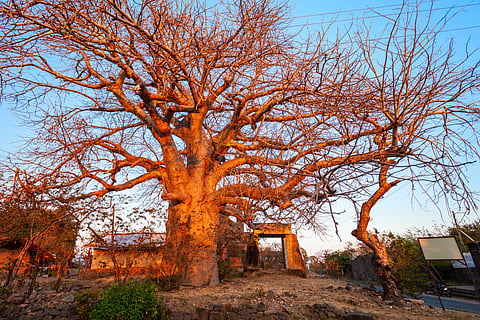
- Destinations
- Experiences
- Stay
- What's new
- Celebrating People
- Responsible Tourism
- CampaignsCampaigns
- Subscribe
- Buy Now

An old man with a receding hairline barely trying to hide his paunch in his pants, with other old men like him, laughing away the sorrows of their long lost youth; if Baobab trees could talk, they would be such annoying old men. Such is the persona of this tree that stands in deserted stretches of land of Africa, with a bottle-shaped trunk that widens at the base and narrows as it goes up, with branches growing out of the top.
This structure allows the tree to store large amounts of water. Baobabs are native to the African continent, but they are mostly found in drier climates, such as Madagascar, and do not thrive in tropical regions.
While travelling to Madagascar to witness the ancient trees in their full glory can be an enthralling experience, you will be surprised to know that some species of this peculiar tree reside in parts of India including Mandu in Madhya Pradesh.
In the midst of subtropical India, there exists a small group of Baobab trees that are far away from their original habitat. Mandu, a town located in the Dhar district of Madhya Pradesh, India, is home to a unique wonder known as Mandu ki Imli, also called the Baobab Tree. The town is known for its abundance of baobab trees, estimated to be around 1,000 in number, situated in the periphery of Mandu.
Spread across the peaceful lanes of Mandu, these Baobab Trees (Adansonia digitata) were brought here by African traders more than 4,000 years ago. Despite their unfamiliar surroundings, they stand tall and majestic, completely unaware of their foreign presence on this continent.
This tree is also known as the Kalpavriksha or the upside-down tree because it appears to be planted upside down. Its homeland is Madagascar, where it is referred to as 'the tree of life' due to its life-giving properties and the hope and shelter it provides in the barren and unforgiving landscape.
Baobab trees are the most abundant species in Mandu town, located in Madhya Pradesh. Historically, the Bhil tribe has been responsible for preserving these trees. For centuries, baobab trees have been a source of livelihood for the tribal population in the Mandu district of Madhya Pradesh. Local shopkeepers, who are mostly members of the Bhil tribe, sell fruit pods of the baobab tree as souvenirs to tourists. These shopkeepers either collect them from the nearby jungle or purchase them from people who cultivate baobabs.
Baobab trees are commonly found in Mandu, but they have also been spotted in Prayagraj (formerly known as Allahabad) in Uttar Pradesh, as well as in Wai in Maharashtra, and certain areas in Gujarat and Andhra Pradesh. They can also be found in the Kutch and Kathiawar peninsula, and are abundant in Goa, Malwa, and the south central Deccan plateau in Andhra Pradesh.
